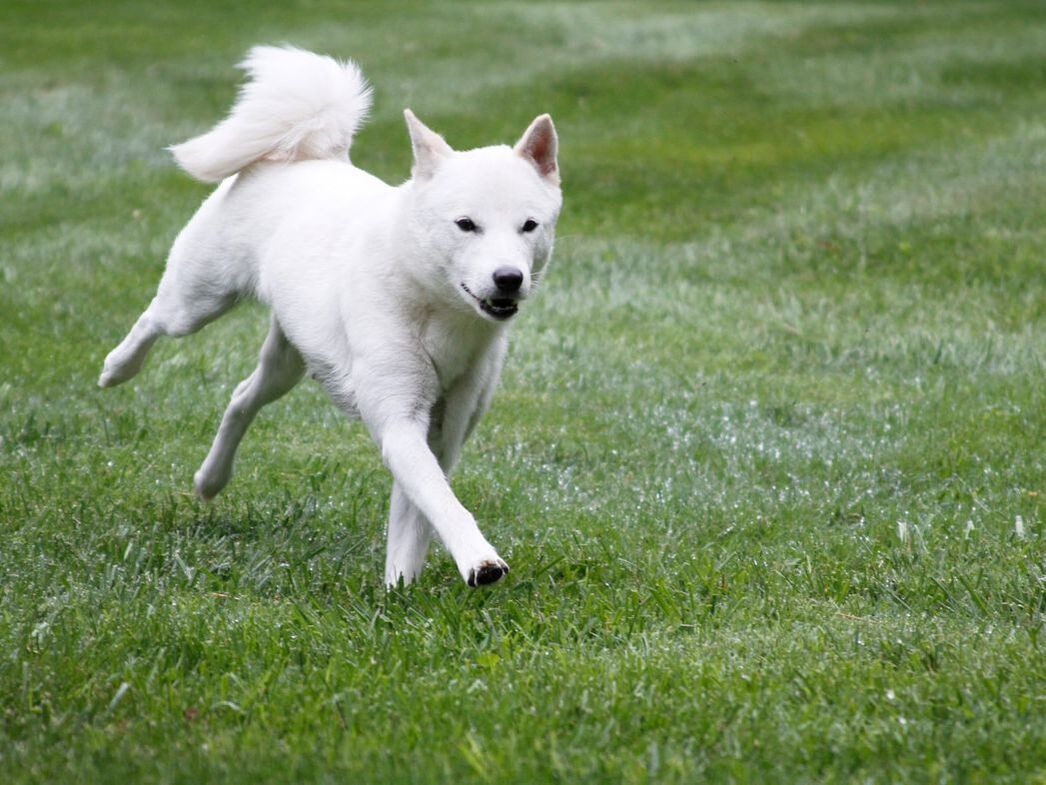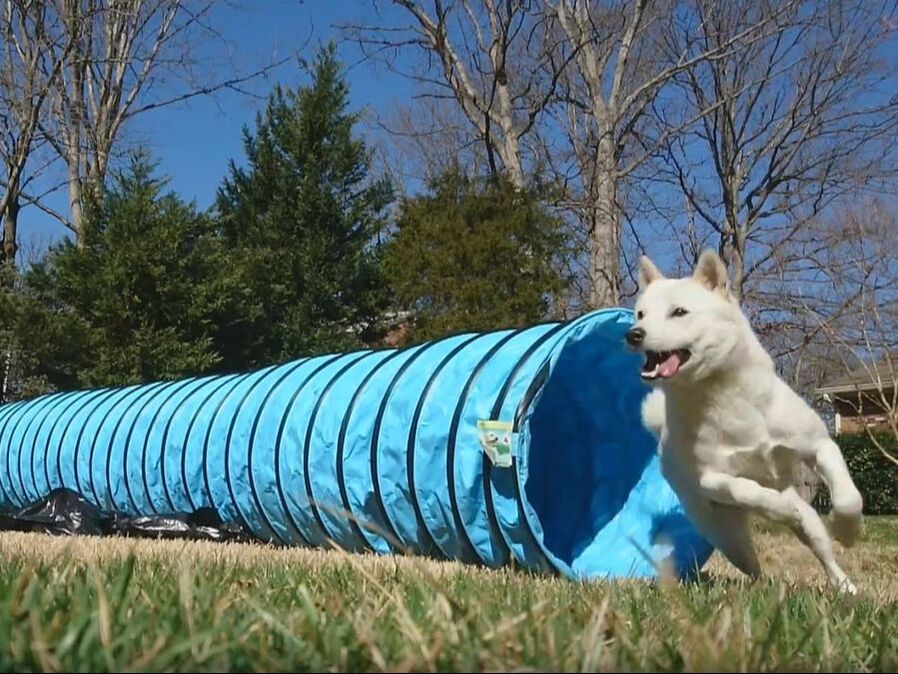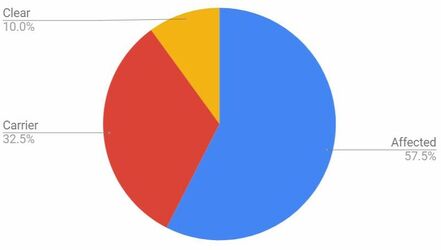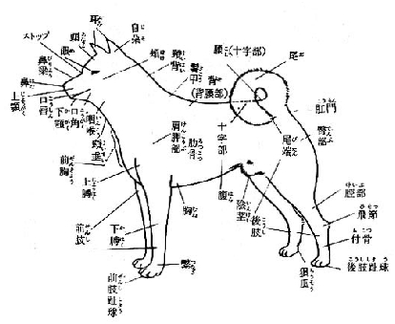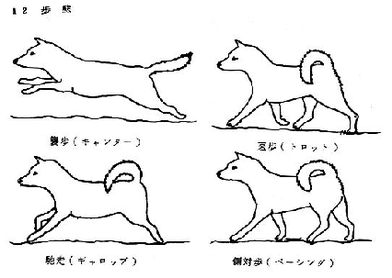About the Hokkaido Ken
The Hokkaido is a brave, devoted, and intelligent breed. They originated from the hunting dogs accompanying migrants from Honshu (the main island of Japan) to Hokkaido (the northernmost island of Japan) in the mid 1100s. The dogs were bred to hunt large game such as deer, elk, and bear. Their broad chest, strong build, thick coat, and small ears helped them survive the severely cold Hokkaido climate. The breed was originally known as the Ainu-ken, after the native Ainu people who once lived on Hokkaido. When the breed was designated as a "living monument" of Japan in 1937, the name was formally changed to Hokkaido Inu. Today, most native Japanese people refer to the breed as Hokkaido Ken, or simply Hokkaido.
The Hokkaido's medium size combined with their exceptional agility, strength, and stamina allows for the perfect active companion. They crave human affection, and love nothing more than to be with their owner. Yuki likes to follow me around the house and sleep by my feet whenever I sit down. The Hokkaido's adoration and dedication towards their owner is something unmatched by any other breed. Hokkaido will sometimes howl like a wolf while waiting for their owners to return home, as well as "roo" in delight when their owner gives them affection. Though you will rarely hear one bark, they are a very vocal breed and can make a wide variety of unique sounds. Please take this into consideration if you are looking to add a Hokkaido to your family.
Because of their independent and bold nature, the Hokkaido requires training and socialization from an early age. If not socialized properly, Hokkaido can become wary of strangers and protective of their families. Given their hunting background, Hokkaido can be small animal aggressive. While human aggression is rarely seen in Hokkaido, dog aggression (particularly seen in intact males) is fairly common.
The Hokkaido is breed that does not like seeing their human family upset with them. They are extremely intelligent and quick learners... but like all Nihon Ken, can become stubborn and resistant if not trained from an early age. All of our puppy buyers are required to take their Hokkaido puppy to a minimum 6 weeks of formal obedience training classes before their puppy's 6 month birthday. Even if you did not purchase your Hokkaido from us, we highly recommend you do the same. Look for a positive (reward based) trainer. Avoid trainers who use adversaries such as prongs, chokes, or e-collars. The dominance or "alpha dog" theory is an unacceptable training tactic with this breed! Although Hokkaido can be good city dogs in the right situation, this active breed needs daily exercise to keep them fit and mentally sound. When not exercised, the Hokkaido can become bored, anxious, and hyperactive.
Overall, the Hokkaido does best with an experienced, active dog owner. With proper socialization and training, Hokkaido make great family companions. If you have the time and desire necessary, you will not be disappointed with this breed!
The Hokkaido's medium size combined with their exceptional agility, strength, and stamina allows for the perfect active companion. They crave human affection, and love nothing more than to be with their owner. Yuki likes to follow me around the house and sleep by my feet whenever I sit down. The Hokkaido's adoration and dedication towards their owner is something unmatched by any other breed. Hokkaido will sometimes howl like a wolf while waiting for their owners to return home, as well as "roo" in delight when their owner gives them affection. Though you will rarely hear one bark, they are a very vocal breed and can make a wide variety of unique sounds. Please take this into consideration if you are looking to add a Hokkaido to your family.
Because of their independent and bold nature, the Hokkaido requires training and socialization from an early age. If not socialized properly, Hokkaido can become wary of strangers and protective of their families. Given their hunting background, Hokkaido can be small animal aggressive. While human aggression is rarely seen in Hokkaido, dog aggression (particularly seen in intact males) is fairly common.
The Hokkaido is breed that does not like seeing their human family upset with them. They are extremely intelligent and quick learners... but like all Nihon Ken, can become stubborn and resistant if not trained from an early age. All of our puppy buyers are required to take their Hokkaido puppy to a minimum 6 weeks of formal obedience training classes before their puppy's 6 month birthday. Even if you did not purchase your Hokkaido from us, we highly recommend you do the same. Look for a positive (reward based) trainer. Avoid trainers who use adversaries such as prongs, chokes, or e-collars. The dominance or "alpha dog" theory is an unacceptable training tactic with this breed! Although Hokkaido can be good city dogs in the right situation, this active breed needs daily exercise to keep them fit and mentally sound. When not exercised, the Hokkaido can become bored, anxious, and hyperactive.
Overall, the Hokkaido does best with an experienced, active dog owner. With proper socialization and training, Hokkaido make great family companions. If you have the time and desire necessary, you will not be disappointed with this breed!
Hokkaido Ken Health
Well-bred Hokkaido are generally very healthy, living 12-15 years. However, like all breeds they are prone to hereditary diseases. Collie Eye Anomaly is a non-progressive, recessive genetic mutation liked to vision impairment, depth perception issues, and even total blindness in severe cases. CEA is found quite commonly in Hokkaido, and breed clubs both in the US and overseas are working diligently to help prevent affected puppies. A study was done in Japan in 2011 to report the allelic frequency of the CEA-associated mutation in the breed. A follow up study was done by the Hokkaido Association in North America in 2019 to test the US population.
Like most breeds Hokkaido are also prone to Canine Hip Dysplasia, a polygenic disorder which causes degeneration of the hip joint over time. A few Hokkaido have also been diagnosed with Idiopathic Seizures, which means there is currently no identifiable underlying cause of the seizures they get. Mostly observed in Japan, heart murmurs are also a growing problem for the breed. Lastly, there is concern among many Hokkaido owners about a condition called Pica, or a dog's craving of non-food items, and the subsequent eating of said item. Many Hokkaido have been found ingesting rocks, stick fragments, socks, tennis balls, and more. While more research is needed to determine the underlying physical or psychological cause of such disorder, it is thought to be largely energy and/or anxiety related. We cannot stress enough the imporance of providing your Hokkaido with some sort of mental stimulation thoughout the day. This can be in the form of trick training, puzzle toys, logic games, bones & chews, scent games, long walks, and/or working towards a performance title.
Nevertheless, with quality stock and responsible breeding, the Hokkaido is a very healthy dog. Working with a responsible breeder can gain you the education you need about specific health concerns within certain bloodlines. Good breeders utilize genetic testing of their breeding stock to reduce the likelihood of disease and defect in their puppies. When you are looking for a Hokkaido, demand to see health screenings for both parents before you make your purchase.
The Hokkaido Association of North America recommends the following health pre-breeding health clearances:
|
MANDATORY CLEARANCES
• OFA or PennHIP Hip Dysplasia Evaluation • OFA Cardiac Evaluation • OFA/CERF Eye Examination • Collie Eye Anomaly (CEA) DNA Test |
OPTIONAL CLEARANCES
• Degenerative Maliopathy (DM) DNA Test • Progressive Retinal Atrophy (PRA) DNA Test • OFA Patellar Luxation Evaluation • OFA Elbow Dysplasia Evaluation • OFA Thyroid Evaluation |
Hokkaido Ken Breed Standards
Hokkaido Ken hozonkai
Download the PDF Here
北海道犬の標準体型(昭和29年4月11日制定)
STANDARD FORM OF THE HOKKAIDO DOG (effective as of April 11, 1945)
北海道犬の標準体型(昭和29年4月11日制定)
STANDARD FORM OF THE HOKKAIDO DOG (effective as of April 11, 1945)
|
1 外貌と気質 素朴感あり、性相判然とし、体躯均衡をえてよく乾燥し、骨格は緊密、筋腱は強靭で逞しい。逞威に富み良性で、感覚は鋭敏、動作は活発敏捷、歩 態は軽快で弾力がある。 1. GENERAL APPEARANCE The Hokkaido has a rustic appearance. Secondary sex characteristics are clearly defined. He is balanced, clean cut, and well muscled. He is highly intelligent, keen, active, and agile. His movement is light, easy, and strong. 2 体 躯 ほぼ正方形の姿態を示し、やや前勝ちの感がある。
2. BODY The Hokkaido has a strong, compact appearance, and he has a sense of dignity.
|
3 頭 部
額広く頬部はよく発達し、前額の縦溝および額段は浅いが明瞭である。
- (1)耳 三角形で小さくよく緊まり、両耳の中央線は、ほぼ並列し、額段に対しておおむね直角に立つ。
- (2)目 やや三角形で外眥上がり、突出することなく、虹彩は暗褐色である。その表情は溌剌として注意深く、かつ大胆性を示す。
- (3)口吻 鼻梁は真直で、口唇および鼻鏡はよく緊まり、歯牙は強健で正し く咬合する
3. HEAD
The forehead is wide with strongly developed cheeks. The stop is shallow but defined.
- Ears: The ears are triangular, small, and thick. When viewed from the front, the ears should be parallel to each other and should stand at a 90 degree angle to the forehead.
- Eyes: The eyes are triangular shaped. They angled upwards from the inside corner to the outside corner of the eye. Eyes are dark brown in color. The expression they give is careful, wary, and it shows boldness.
- Muzzle: The nasal bridge is straight, the lips are tight and tense, and the teeth are strong.
4 頸
頸は力強く逗ましい。喉皮は弛緩しない。
4. NECK
The neck is strong, powerful, and clean cut. The skin should be tight and not loose.
5 胸・胴
胸は深く、肋は張って適度の巾をもち、前胸は発達している。背は真直で強勤である。
5. CHEST AND TORSO
The chest is deep, the ribs are well sprung, and the forechest is well developed. The back is straight and strong.
6 腹・腰・尻
腹は胸に調和して巻き、腰は強勤で適度の巾をもち、尻はやや傾斜する。
6. GIRTH, WAIST, AND COUP
The girth is proportional to the chest, the loin is strong with moderate width, and the coup is slightly inclined.
7 前 肢
肩甲骨は適度に傾斜し、肩端は出過ぎることなく、肢勢は真直である。
7. FOREQUARTERS
The shoulder is slightly sloping, the forearm is moderately angled, and the front limbs are straight.
8 後 肢
力強く踏み、飛節は適度の角度をもち、よく乾燥し、弾発力に富む。
8. HINDQUARTERS
The rear is strong, moderately angled, clean cut, and resilient.
9 趾 部
握りよく、趾間関かず趾肉厚く、爪は毛色に応じ黒色または暗色である。
9. FEET
Paws grip well, toes are thick, and nails are black or darkly colored
10 被 毛
表毛は剛にして直で適度の角度があり、綿毛は軟にして密生する。
10. COAT
Outercoat is rigid, straight, and moderately angled. Undercoat is soft and dense.
11 尾
太く力強い巻尾または差尾で、長さは、ほぼ飛端に達する。
11. TAIL
Tail is thick and strong. When let down, the length almost reaches the hock.
12 毛色
赤・白・黒褐・虎・狼灰・胡麻およびそれらの変化色がある。
12. COAT COLOR
Red, white, black & tan, brindle, wolf grey, and sesame
United Kennel Club (UKC)
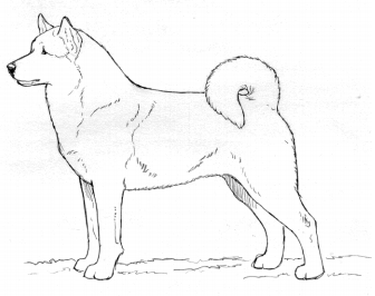
Download the PDF Here
GENERAL APPEARANCE - The Hokkaido is a medium sized, spitz type breed that has strongly developed secondary sex characteristics. It is well balanced, sturdily built and strongly boned. The breed is capable of withstanding severe cold and heavy snowfall. Its tough, clean cut muscles give it great stamina.
Faults: Secondary sex characteristics not well defined.
CHARACTERISTICS - The Hokkaido is a dog with great dignity. It has a faithful, docile, alert and bold temperament.
SKULL - The skull is broad and slightly flat. It is approximately the same length as the width of the head at the cheeks. There is a shallow, but defined, stop.
MUZZLE - The muzzle is wedge shaped, with a straight nasal bridge. It is about two-thirds the length of the skull. The lips are tight and have black edges.
TEETH - The Hokkaido has a complete set of evenly spaced, white teeth meeting in a scissors bite.
Faults: Slightly overshot or undershot bite.
Disqualification: Extremely overshot or undershot bite.
NOSE - The nose is black, except in white colored dogs, where a flesh colored nose is allowed.
EYES - The eyes are relatively small, nearly triangular in shape, set well apart, and dark brown in color.
EARS - The small, erect ears are triangular in shape and inclined slightly forward.
Disqualification: Ears not prick.
NECK - Powerful and muscular, with no dewlap.
FOREQUARTERS - The shoulders are moderately sloping.
FORELEGS - The legs are straight and clean cut, with good bone and slightly sloping pasterns.
BODY - In proportion, the Hokkaido is slightly longer than tall in a ratio of 11:10. The chest is deep and moderately broad, with a well developed forechest. The ribs are well sprung. The withers are high and the back is straight and strong. The loin is moderately broad and muscular and the croup is slightly sloping. There is a good amount of tuck up.
HINDQUARTERS - The hindquarters are powerful, with strong hocks.
FEET - The feet have close, well arched toes and hard, elastic pads. The nails are hard and dark in color.
TAIL - The tail is set on high. It is thick and carried over the back in a curl or in sickle shape. The tip nearly reaches the hocks when the tail is let down. Disqualifications: Hanging or short tail.
COAT - Double, with a harsh, straight outer coat and a soft, dense undercoat. The hair on the tail is fairly long and stands off in a brush.
COLOR - Sesame (red fawn hairs with black tips), brindle, red, black, black and tan or white.
HEIGHT - Height at the withers for males is 19 to 20.5 inches. For females, it is 18 to 19 inches.
GAIT - At a trot, the gait is active, light and quick.
DISQUALIFICATIONS:
(A dog with a Disqualification must not be considered for placement in a conformation event, and must be reported to UKC.)
~ Breed Standard was effective 1996 ~
GENERAL APPEARANCE - The Hokkaido is a medium sized, spitz type breed that has strongly developed secondary sex characteristics. It is well balanced, sturdily built and strongly boned. The breed is capable of withstanding severe cold and heavy snowfall. Its tough, clean cut muscles give it great stamina.
Faults: Secondary sex characteristics not well defined.
CHARACTERISTICS - The Hokkaido is a dog with great dignity. It has a faithful, docile, alert and bold temperament.
SKULL - The skull is broad and slightly flat. It is approximately the same length as the width of the head at the cheeks. There is a shallow, but defined, stop.
MUZZLE - The muzzle is wedge shaped, with a straight nasal bridge. It is about two-thirds the length of the skull. The lips are tight and have black edges.
TEETH - The Hokkaido has a complete set of evenly spaced, white teeth meeting in a scissors bite.
Faults: Slightly overshot or undershot bite.
Disqualification: Extremely overshot or undershot bite.
NOSE - The nose is black, except in white colored dogs, where a flesh colored nose is allowed.
EYES - The eyes are relatively small, nearly triangular in shape, set well apart, and dark brown in color.
EARS - The small, erect ears are triangular in shape and inclined slightly forward.
Disqualification: Ears not prick.
NECK - Powerful and muscular, with no dewlap.
FOREQUARTERS - The shoulders are moderately sloping.
FORELEGS - The legs are straight and clean cut, with good bone and slightly sloping pasterns.
BODY - In proportion, the Hokkaido is slightly longer than tall in a ratio of 11:10. The chest is deep and moderately broad, with a well developed forechest. The ribs are well sprung. The withers are high and the back is straight and strong. The loin is moderately broad and muscular and the croup is slightly sloping. There is a good amount of tuck up.
HINDQUARTERS - The hindquarters are powerful, with strong hocks.
FEET - The feet have close, well arched toes and hard, elastic pads. The nails are hard and dark in color.
TAIL - The tail is set on high. It is thick and carried over the back in a curl or in sickle shape. The tip nearly reaches the hocks when the tail is let down. Disqualifications: Hanging or short tail.
COAT - Double, with a harsh, straight outer coat and a soft, dense undercoat. The hair on the tail is fairly long and stands off in a brush.
COLOR - Sesame (red fawn hairs with black tips), brindle, red, black, black and tan or white.
HEIGHT - Height at the withers for males is 19 to 20.5 inches. For females, it is 18 to 19 inches.
GAIT - At a trot, the gait is active, light and quick.
DISQUALIFICATIONS:
(A dog with a Disqualification must not be considered for placement in a conformation event, and must be reported to UKC.)
- Unilateral or bilateral cryptorchid.
- Viciousness or extreme shyness.
- Albinism.
- Extremely overshot or undershot bite.
- Ears not prick.
- Hanging or short tail.
~ Breed Standard was effective 1996 ~
Fédération Cynologique Internationale (FCI)
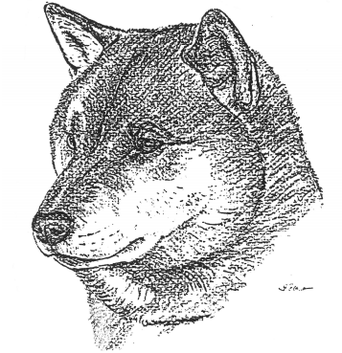
Download the PDF Here
GENERAL APPEARANCE : Medium-sized dog with secondary sex characteristics strongly marked, well balanced, sturdily built and well boned. Muscles tough and clean cut.
IMPORTANT PROPORTIONS :
BEHAVIOUR / TEMPERAMENT : Dog of noteworthy endurance, showing dignity and naive feeling. The temperament is faithful, docile, very alert and bold.
HEAD CRANIAL REGION : Skull and forehead is broad and slightly flat. Stop is shallow, but defined.
FACIAL REGION : Nose is black, but flesh colour permitted with a white coat. Muzzle is wedge-shaped. Nasal bridge is straight. Lips are tight, with black edges. Jaws/Teeth are strong, with a scissor bite. Cheeks are well developed. Eyes are relatively small, nearly triangular, set well apart and dark brown in colour. Ears are small, triangular, slightly inclining forward and firmly pricked.
NECK : Powerful and muscular, free from dewlap.
BODY : Withers are set high. Back is straight and strong. Loins is moderately broad and muscular. Croup is properly sloping. Forechest is well developed, deep, and moderately broad; ribs well sprung. Belly is well tucked up.
TAIL : Set on high, thick and carried over the back vigorously curled or curved like a sickle, the tip nearly reaching hocks when let down.
FOREQUARTERS : Shoulders are moderately sloping. Forearm is straight and clean cut. Pasterns are lightly inclining.
HINDQUARTERS : General appearance is powerful. Hocks are tough and sufficiently strong.
FEET : Toes well arched and tightly closed; pads hard and elastic; nails hard and black or dark colour.
GAIT / MOVEMENT : Active, quick, light and resilient.
COAT HAIR : Outer coat harsh and straight; undercoat soft and dense. The hair on the tail fairly long and off-standing.
COLOUR : Sesame (red fawn hairs with black tips), brindle, red, black, black and tan, white.
SIZE : Dogs 48.5 - 51.5 cm (19 - 20 in); Bitches 45.5 - 48.5 cm (18 - 19 in)
FAULTS : Any departure from the foregoing points should be considered a fault and the seriousness with which the fault should be regarded should be in exact proportion to its degree and its effect upon the health and welfare of the dog. Blue-Black colour in tongue is not a fault!
DISQUALIFYING FAULTS :
"Only functionally and clinically healthy dogs, with breed typical conformation should be used for breeding."
~ Breed Standard was effective December 20, 1994 ~
GENERAL APPEARANCE : Medium-sized dog with secondary sex characteristics strongly marked, well balanced, sturdily built and well boned. Muscles tough and clean cut.
IMPORTANT PROPORTIONS :
- The ratio of height at withers to length of body is 10 : 11
- The ratio of skull to length of nasal bridge is 3 : 2.
- Length of skull equal to width of cheeks, being about one fourth of height at withers.
BEHAVIOUR / TEMPERAMENT : Dog of noteworthy endurance, showing dignity and naive feeling. The temperament is faithful, docile, very alert and bold.
HEAD CRANIAL REGION : Skull and forehead is broad and slightly flat. Stop is shallow, but defined.
FACIAL REGION : Nose is black, but flesh colour permitted with a white coat. Muzzle is wedge-shaped. Nasal bridge is straight. Lips are tight, with black edges. Jaws/Teeth are strong, with a scissor bite. Cheeks are well developed. Eyes are relatively small, nearly triangular, set well apart and dark brown in colour. Ears are small, triangular, slightly inclining forward and firmly pricked.
NECK : Powerful and muscular, free from dewlap.
BODY : Withers are set high. Back is straight and strong. Loins is moderately broad and muscular. Croup is properly sloping. Forechest is well developed, deep, and moderately broad; ribs well sprung. Belly is well tucked up.
TAIL : Set on high, thick and carried over the back vigorously curled or curved like a sickle, the tip nearly reaching hocks when let down.
FOREQUARTERS : Shoulders are moderately sloping. Forearm is straight and clean cut. Pasterns are lightly inclining.
HINDQUARTERS : General appearance is powerful. Hocks are tough and sufficiently strong.
FEET : Toes well arched and tightly closed; pads hard and elastic; nails hard and black or dark colour.
GAIT / MOVEMENT : Active, quick, light and resilient.
COAT HAIR : Outer coat harsh and straight; undercoat soft and dense. The hair on the tail fairly long and off-standing.
COLOUR : Sesame (red fawn hairs with black tips), brindle, red, black, black and tan, white.
SIZE : Dogs 48.5 - 51.5 cm (19 - 20 in); Bitches 45.5 - 48.5 cm (18 - 19 in)
FAULTS : Any departure from the foregoing points should be considered a fault and the seriousness with which the fault should be regarded should be in exact proportion to its degree and its effect upon the health and welfare of the dog. Blue-Black colour in tongue is not a fault!
- Bitchy dog/doggy bitches.
- lightly overshot or undershot mouth.
DISQUALIFYING FAULTS :
- Aggressive or overly shy dogs.
- Any dog clearly showing physical or behavioural abnormalities shall be disqualified.
- Extremely overshot or undershot mouth.
- Ears not pricked.
- Hanging or short tail.
- Shyness.
"Only functionally and clinically healthy dogs, with breed typical conformation should be used for breeding."
~ Breed Standard was effective December 20, 1994 ~
